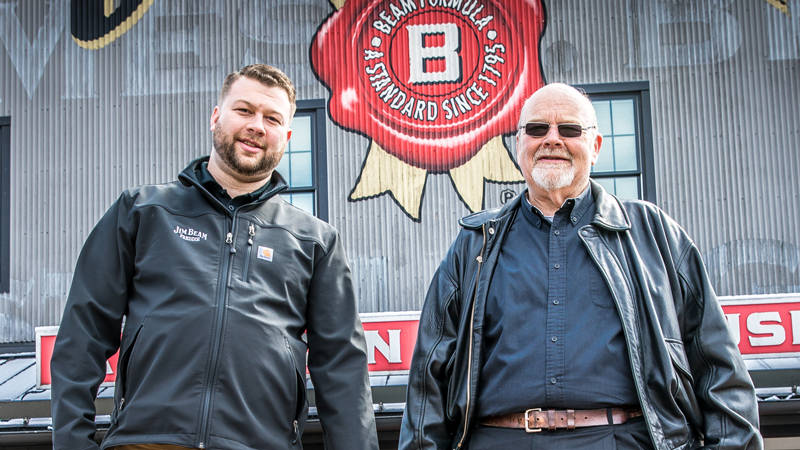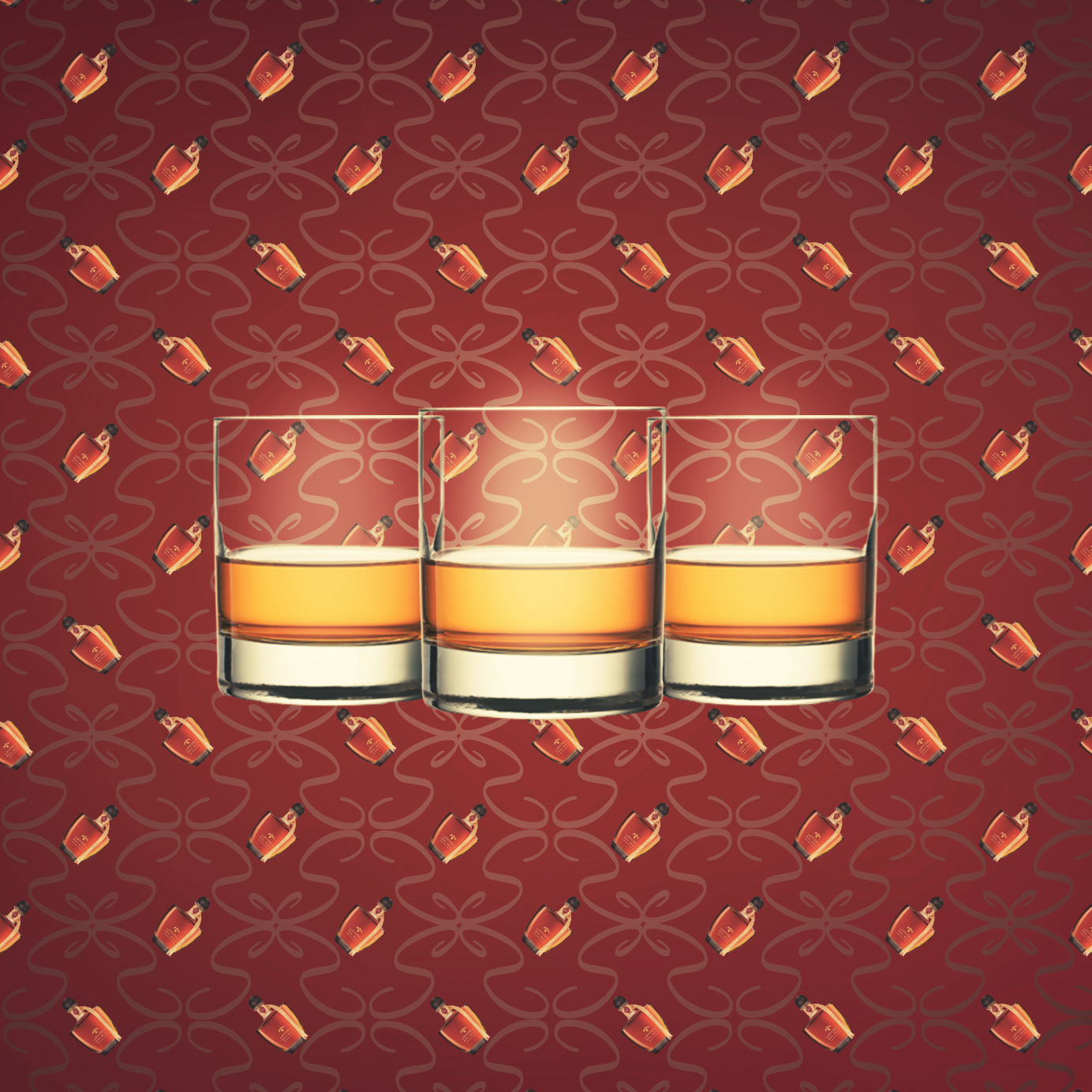What if I told you a new, limited-edition bourbon was hitting the market soon. Eighteen years old, 99 proof, finished in Fussigny Cognac casks. There are only about 5,000 bottles available.
What would you pay for that?
What if I told you the bottle itself was in a French crystal decanter, delicately acid-etched with the images of oak leaves, worth $75 even when empty.
Now what would you pay?
Today those bonafides might come with an MSRP of several thousand dollars, and they would clear out of liquor stores fast. But when Jim Beam Distiller’s Masterpiece was released, in 1999 for $250, it quietly sat on shelves gathering dust for nearly a decade. Today, it is finally starting to be revisited as a classic well before its time, a visionary whiskey that ushered in a new era of high-end, collectible bourbon.
In 1999, the world was obsessed with vodka. Pappy Van Winkle 15 Year Old was still five years away from being released, and many more years away from dominating cultural conversation. If you bought a “fancy” bourbon for your upcoming Y2K party, it might run you 30 bucks at best.
So why in the world did Jim Beam decide to release, into this seemingly uninterested marketplace, an 18-year-old bourbon finished in Cognac barrels at such a jaw-dropping price?
“Dad had sold some whiskey to a fella from Asia, who wanted to bottle it at a much older age than we normally do,” Fred Noe, Booker Noe’s son and Jim Beam’s current master distiller, says. Fred was running the bottling and labeling in the late 1990s. “So we sold him the barrels right off the still,” he says. “We’ll bottle them whenever you want, we told him. Then, the Asian economy began to tank, and he needed to get out of the deal. So he sold the barrels back to us and we took ’em.”
By that point the bourbon was around 16 years old and quite woody. Way older than anything Jim Beam had ever sold — heck, older than almost any bourbon that had ever hit the the shelves back then. Booker Noe had no idea what to do with it — until he came up with a clever solution.
At the time Jim Beam had a distribution partnership with Fussigny, Alain Royer’s renegade Cognac house. Booker wondered what might happen if he put the woody bourbon in some of Royer’s Cognac casks for a year or so. Hopefully the sweeter brandy notes might tone it down a bit. So Beam took half the lot of older bourbon and tried just that.
Back in the late-1990s, “finishing” whiskey was not as common a practice as it is today. In fact, no bourbon company had never done it before — take a bourbon from its original oak barrel and then put it into another cask for the final few months of its aging life. The Scotch industry had only been doing the practice itself since around 1983, with Balvenie generally credited as being the first to intentionally move its product from ex-bourbon casks into ex-Oloroso sherry butts. Glenmorangie had likewise just begun exploring the finishing — or secondary maturation — of its whiskies in former wine casks. Though an offbeat, if not unheard of practice in America at the time, Booker’s gambit worked.
“The Cognac cultured the backwoodsman with utter finesse and also left its distinct brandy taste on the palate,” Cigar Aficionado noted in a stellar review.
The next challenge was getting such a laboriously created whiskey to consumers. In 1999 Jim Beam only had about half a dozen products available. White, Black, Beam’s Choice, 8 Star Blend, and the Small Batch line. The most expensive of those was the eponymous Booker’s, a six- to eight-year-old barrel-strength offering, first released in 1987, that retailed for $39.99. A ton of money in the day, it was both one of the most expensive and intentionally limited releases up to that point in bourbon history.
This new product would take the name Distiller’s Masterpiece, even if master distillers hadn’t yet become the rock stars they are today. (As Fred Noe told me, “Booker wasn’t yet famous in 1999, not so much. Bourbon was still a slow sell because we hadn’t run through all the flavors of vodka yet. Cinnabon-flavored vodka and the like.”) The bottles were teardrop shaped, with oak leaves etched around the top, and Booker Noe’s and Alain Royer’s signatures on the front. It came in sturdy wood boxes that folded open like a book.
“They were trying to play on the Louis — what’s it called? — Treiz fancy back bar pieces,” Noe recalls, citing the now-famous $3,000 Cognac beloved by rain-making rappers and Wall Streeters.

Reminiscent of Cognac, and priced at $250 in 1999, Distiller’s Masterpiece was up there with the most expensive Scotches available at the time. Booker’s plan was to sell it to fancy restaurants, steakhouses mainly, as opposed to retail consumers. That was one reason why you could register your bottle and have Jim Beam send you an engraved plaque, perfect for displaying in the kinds of places that have customers on expense accounts who don’t mind shelling out for $50 shots.
“I thought Dad had gone bonkers,” Noe says. “‘What are you thinking with that price?’ I asked him.”
Whether due to its experimental flavor profile or sizable price tag, it was clearly a few years ahead of its time. Bottles were easy to get if you had the loot.
A second Distiller’s Masterpiece came out in 2002 using the other half of those initial barrels. This edition was now 20 years old and finished in tawny and vintage port casks from California’s Geyser Peak winery. It also came in a French glass decanter etched with oak leaves, sealed with an individually numbered gold-crested cap (this time only 2,500 bottles), with the price upped to $300. “[A]nother refined flavor bomb,” Cigar Aficionado wrote this time.
These bottles may not have been flying off store shelves, but at least the industry was taking notice of the ambition. Richard Carleton Hacker of Robb Report named the 20 Year one of the best spirits of the year. And, in the September 2002 issue of Wine Enthusiast, in an article about cutting-edge distilleries, mainly due to these two Distiller’s Masterpiece releases, Gary Regan called Jim Beam “arguably Bourbon County’s brightest star.”
We were on the brink of a new era in bourbon. After Pappy Van Winkle 15 Year Old came out in 2004, all bets were off. By 2017 Buffalo Trace was selling an Old Rip Van Winkle 25 Year Old that came in a handmade Glencairn Crystal decanter topped with a silver stopper, in a box made of the barrel staves that had previously held the bourbon. It initially cost $1,800 but that was clearly underpriced — it would almost immediately begin trading for $10,000-plus on the secondary market.
In 2007 Four Roses began releasing its own limited editions, beginning with 1,442 bottles of a barrel-proof offering that celebrated master distiller Jim Rutledge’s 40 years in the industry. Today, the company’s yearly “LEs” are some of the most coveted among the cognoscenti. Heaven Hill likewise began its own limited-edition program in 2007 with the Parker’s Heritage Collection, meant to honor its own long-time master distiller Parker Beam. (The 2011 edition of Parker’s Heritage would be amusingly finished in Alain Royer’s Cognac barrels as well, something that still pisses Noe off a bit).
Eventually, this newly-created breed of rarity-obsessed, free-spending bourbon collectors started revisiting the two Distiller’s Masterpieces.
“In every way [Distiller’s Masterpiece] was a weird whiskey for the market to absorb back then and that’s why, until a few years ago, you could see them sitting on the top shelf of liquor stores collecting dust,” Josh Peters wrote on his Whiskey Jug blog in 2016. Today, the 1999 release sells for around $1,000 through auction houses.
By 2013, when the third edition Distiller’s Masterpiece came out, the bourbon market had radically shifted. Booker had been dead since 2004 and Fred Noe was now fully at the helm of the project. Noe would use the same finishing technique as his father, though this time with PX sherry casks. Bottles were meant to be sold only at their newly opened visitor’s center in Clermont.
“When we opened the [Jim Beam American Stillhouse], we wanted something people could only buy there,” Noe explains. “But then we had sales guys saying, ‘Why can’t we have that?’ Off-premise accounts started sending visitors and taking them back to their bars.” Eventually Jim Beam made a bigger batch and actually sent them to all their markets — some bottles of which you’ll still see lingering on higher-end whiskey menus across the world.
In 2016, when Jim Beam released the first-ever Booker’s Rye for $299, it sold so briskly that bottles were almost impossible to find at retail. It quickly jumped to $750 on the secondary market and remains red hot among collectors nearly two years later. In less than two decades, ultra-premium American whiskey had gone from a lark to stirring unyielding fanaticism. Even Noe is a little flummoxed by it all.
“I keep hearing that people now buy bourbon for investments,” Noe says. “They say, ‘Well, it’s not going to lose any value.’ What do you mean? It might! Bourbon might not be cool again one day.
“That’s why the smarter move is always just to drink it.”
